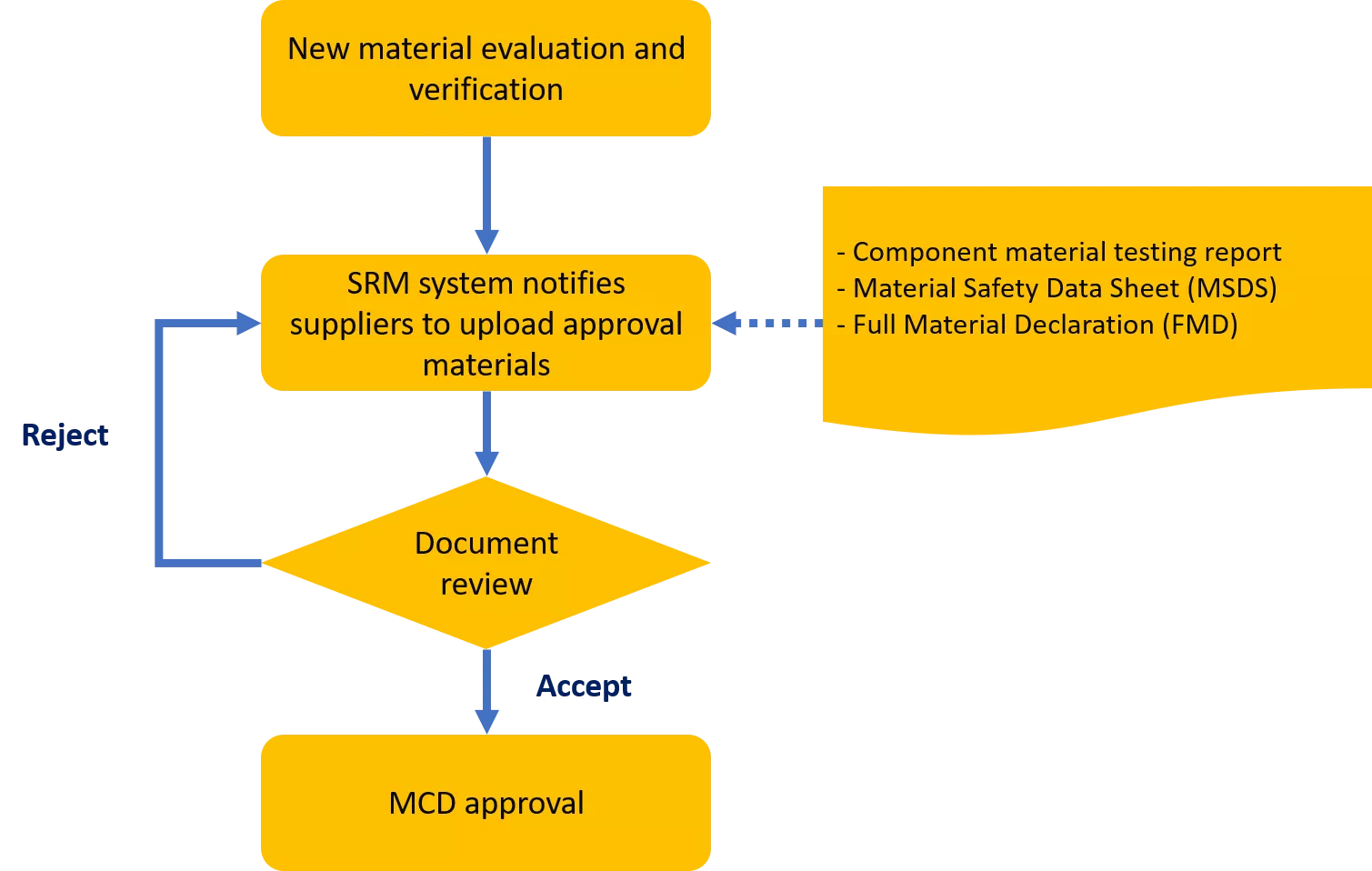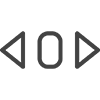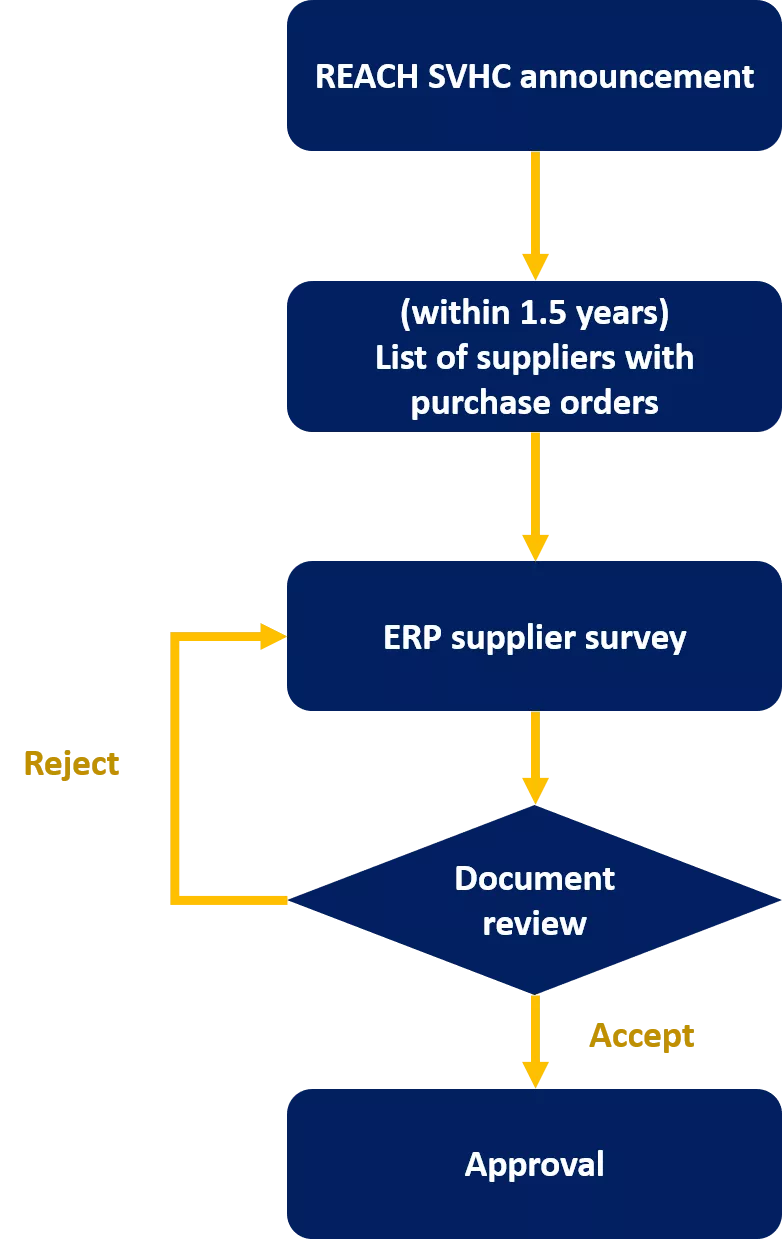Material Hazardous Substance Management
Since 2016, Simplo has voluntarily adopted the FMD mechanism. The FMD helps consumers understand the ingredients of materials and substances used in products. The FMD mechanism uses the green product management platform to investigate the ingredients covered by raw materials, and conduct data analysis and risk assessment. In addition, suppliers must sign the Statement of Conformity (SoC) to ensure compliance with latest regulations. When regulations are revised, the database must could identify high-risk raw materials to ensure that products comply with human health and environmental safety.
List of Hazardous Materials
In order to fulfill corporate sustainability responsibilities, reduce the impact on the environment and ecology, and comply with international regulatory requirements, Simplo Technology regularly checks international directives and relevant regulatory requirements, prohibits or controls their use and content in product materials, and stipulates hazardous substances Management standards. The company establishes a list of hazardous substances and announces the information on the green product management platform (Supplier Relationship Management, SRM) for suppliers and colleagues to follow. Management standards:
- Level 1: The use of these substances and their purposes classified at this level must be banned immediately when over its allowed concentration.
- Level 2: The use of these substances and their purposes classified at this level are phase-out in a specific period. On or after the date set in each table the substances in the respective table will be classified at level 1 and must not be contained in all materials.
- Level 3: In order to monitor the use of hazardous substances in products, when these substances are intentionally used in modules, parts, sub-materials, materials, and the concentration is over its limit, the information of substances classified at this level should be disclosed.
- Exemption: The substance applications classified as “Exemption” are those used for modules, parts, sub-materials, and materials but not regulated by the law or excluded from “the controlled substances” due to the unavailability of adequate alternative parts and materials on the market that satisfies the intended application.。Environment hazardous substances banned and restricted control list.
Hazardous Substance Verification
- Simplo Technology collects hazardous substance test reports, material safety data sheets (MSDS), full substance declarations, material declarations, third-party test reports or supplier compliance statements from suppliers. This information can meet the content of IEC 62474 and can also be traced back to the upstream supplier.
- Simplo Technology clearly stipulates in the purchase contract or order that suppliers of new materials must meet supplier specifications. Suppliers must ensure that all products sold to the company, the raw materials, solvents, consumables, packaging and processes used, etc. They do not contain or use harmful substances prohibited by the laws of the country where the product is located.
- New materials must be inspected and tested by the technology research and development department and must be confirmed in accordance with “ Hazardous Substance Management Standards” to confirm that the new materials to be used meet the specifications or do not contain banned substances. If the supplier's materials are found to violate the hazardous substance management regulations, they will be handled according to the nonconforming product control procedures.
Materials and Parts Approval Process
|
|
 |
|

| Approval information | Frequency |
| Level 3 Hazardous Substances Questionnaire | New material approval/document revision (every year) |
| REACH Substances of Very High Concern (SVHC) Questionnaire | New material approval/document revision (half a year) |
| Declaration of non-use of harmful substances | New material approval/regulation revision (irregular) |
| RoHS test report | New material recognition/report expiration (valid for 2 years) |
| Material Safety Data Sheet | New material recognition/report expiration (valid for 2 years) |
Restriction of Hazardous Substances Directive (RoHS)
The European Union has passed the RoHS Directive to limit the use of hazardous substances in electrical and electronic equipment. The RoHS Directive currently restricts the use of ten substances: lead, cadmium, mercury, hexavalent chromium, polybrominated biphenyls (PBB) and polybrominated diphenyl ethers (PBDE), bis(2-ethylhexyl) phthalate (DEHP), butyl benzyl phthalate (BBP), dibutyl phthalate (DBP) and diisobutyl phthalate (DIBP). Simplo’s factories has implemented the IECQ QC080000 Hazardous Substances Management System and obtained the verification since 2012. All products comply with the limit value requirements of the RoHS directive, and there are no RoHS violations and customer complaints.
Process Chemical Substance Management
Registration, Evaluation, Authorization and Restriction of Chemicals (REACH)
To ensure that products comply with REACH regulations, Simplo takes a series of measures to limit the use of harmful chemical substances, such as not using known hazardous substances, and seeking to use green chemical substances and alternatives; cooperate closely with customers to ensure that they understand the requirements of REACH regulations, And provide corresponding technical support when necessary; maintain communication with third-party laboratories, actively participate in relevant legal training courses; regularly grasp the latest regulatory developments to ensure that products comply with REACH regulations.
|
|
 |
|
In order to prevent the materials or auxiliary solvents used in the manufacturing process from posing hidden hazards to production line personnel and the environment, Simplo Technology's Hazardous Substance Management Standards stipulate that cleaning agents, degreasing agents, and release agents used in the manufacturing process are prohibited from containing benzene. , organic solvents containing bromine, chlorine, n-hexane, toluene, and methanol, and irregular on-site audits are conducted to implement the management of chemical substances in the process and reduce the occurrence of personnel or indirect environmental hazards.
In addition, chemical substances need to be controlled or banned so that customers can use products with more confidence, and it will help reduce environmental pollution at the end of the product's life cycle and improve the safety of waste recycling and processing personnel. Product chemical residue specification items include sulfides, siloxanes, and ammonium ions. Simplo Technology uses a management mechanism including third-party laboratory testing, full-time personnel review, management system audit and review to implement the control of chemical substances in products and provide customers and the environment with safer products.

